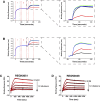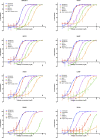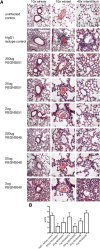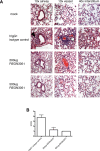Pre- and postexposure efficacy of fully human antibodies against Spike protein in a novel humanized mouse model of MERS-CoV infection
- PMID: 26124093
- PMCID: PMC4507189
- DOI: 10.1073/pnas.1510830112
Pre- and postexposure efficacy of fully human antibodies against Spike protein in a novel humanized mouse model of MERS-CoV infection
Abstract
Traditional approaches to antimicrobial drug development are poorly suited to combatting the emergence of novel pathogens. Additionally, the lack of small animal models for these infections hinders the in vivo testing of potential therapeutics. Here we demonstrate the use of the VelocImmune technology (a mouse that expresses human antibody-variable heavy chains and κ light chains) alongside the VelociGene technology (which allows for rapid engineering of the mouse genome) to quickly develop and evaluate antibodies against an emerging viral disease. Specifically, we show the rapid generation of fully human neutralizing antibodies against the recently emerged Middle East Respiratory Syndrome coronavirus (MERS-CoV) and development of a humanized mouse model for MERS-CoV infection, which was used to demonstrate the therapeutic efficacy of the isolated antibodies. The VelocImmune and VelociGene technologies are powerful platforms that can be used to rapidly respond to emerging epidemics.
Keywords: DPP4; MERS-CoV; Spike; mouse model; neutralizing antibody.
Conflict of interest statement
Conflict of interest statement: K.E.P., A.O.M., V.K., A.B., J.F., C.H., J.S., R.B., G.C., K.-M.V.L., T.T.H., W.O., G.D.Y., N.S., and C.A.K. are employees of Regeneron Pharmaceuticals, Inc. The work was funded by Regeneron Pharmaceuticals, Inc.
Figures












Comment in
-
Reply to Dimitrov et al.: VelociSuite technologies are a foundation for rapid therapeutic antibody development.Proc Natl Acad Sci U S A. 2015 Sep 15;112(37):E5116. doi: 10.1073/pnas.1513935112. Epub 2015 Aug 28. Proc Natl Acad Sci U S A. 2015. PMID: 26318164 Free PMC article. No abstract available.
-
No evidence for a superior platform to develop therapeutic antibodies rapidly in response to MERS-CoV and other emerging viruses.Proc Natl Acad Sci U S A. 2015 Sep 15;112(37):E5115. doi: 10.1073/pnas.1513441112. Epub 2015 Aug 28. Proc Natl Acad Sci U S A. 2015. PMID: 26318165 Free PMC article. No abstract available.
References
-
- Zaki AM, van Boheemen S, Bestebroer TM, Osterhaus ADME, Fouchier RAM. Isolation of a novel coronavirus from a man with pneumonia in Saudi Arabia. N Engl J Med. 2012;367(19):1814–1820. - PubMed
-
- Perlman S, McCray PB., Jr Person-to-person spread of the MERS coronavirus—An evolving picture. N Engl J Med. 2013;369(5):466–467. - PubMed
MeSH terms
Substances
LinkOut - more resources
Full Text Sources
Other Literature Sources
Molecular Biology Databases
Miscellaneous

